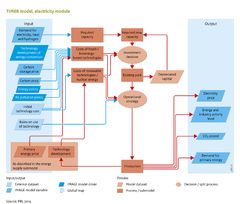Energy conversion/Description: Difference between revisions
Jump to navigation
Jump to search
No edit summary |
No edit summary |
||
| Line 7: | Line 7: | ||
As shown in the flowdiagram, two key elements of the electric power generation model are the descriptions of the investment strategy and the operational strategy within the sector. A challenge of simulating electricity production in an aggregated model is that, in reality, electricity production depends on a whole range of complex factors, such as those related to costs, reliance, and the time it takes to switch on technologies. Modelling these factors requires a very high level of detail. Therefore, IAMs such as TIMER concentrate on introducing a set of simplified, meta relationships ([[Hoogwijk, 2004]]; [[Van Vuuren, 2007]]). | As shown in the flowdiagram, two key elements of the electric power generation model are the descriptions of the investment strategy and the operational strategy within the sector. A challenge of simulating electricity production in an aggregated model is that, in reality, electricity production depends on a whole range of complex factors, such as those related to costs, reliance, and the time it takes to switch on technologies. Modelling these factors requires a very high level of detail. Therefore, IAMs such as TIMER concentrate on introducing a set of simplified, meta relationships ([[Hoogwijk, 2004]]; [[Van Vuuren, 2007]]). | ||
==Total demand for new capacity== | ==Total demand for new capacity en nu een helee lange koptekst die er af loop== | ||
The required electricity capacity needed to meet the demand per region is based on a forecast of the maximum electricity demand plus a reserve margin of about 10%. The maximum demand is calculated on the basis of an assumed monthly shape of the load duration curve ([[HasAcronym::LDC]]) and the gross electricity demand. The latter comprises the net electricity demand (from the end-use sectors) plus electricity trade and transmission losses (the LDC accounts for characteristics such as cooling and lighting demand). The demand for new generation capacity equals the difference between the required and existing capacity. Here, power plants are assumed to be replaced at the end of their lifetime (depending on the technology, varying from 30 to 50 years, and currently fixed in the model). | The required electricity capacity needed to meet the demand per region is based on a forecast of the maximum electricity demand plus a reserve margin of about 10%. The maximum demand is calculated on the basis of an assumed monthly shape of the load duration curve ([[HasAcronym::LDC]]) and the gross electricity demand. The latter comprises the net electricity demand (from the end-use sectors) plus electricity trade and transmission losses (the LDC accounts for characteristics such as cooling and lighting demand). The demand for new generation capacity equals the difference between the required and existing capacity. Here, power plants are assumed to be replaced at the end of their lifetime (depending on the technology, varying from 30 to 50 years, and currently fixed in the model). | ||
Revision as of 15:54, 6 January 2014
Parts of Energy conversion/Description
| Component is implemented in: |
|
| Related IMAGE components |
| Projects/Applications |
| Models/Databases |
| Key publications |
| References |
